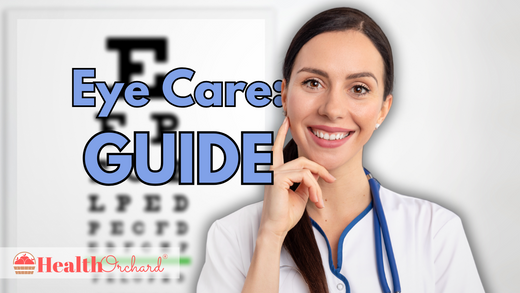

Eye Care: Guide
Key Takeaways
- Regular Eye Exams Are Essential: Early detection through routine check-ups can prevent or manage severe eye conditions.
- Healthy Habits Support Vision: A nutrient-rich diet, UV protection, and good hygiene practices help maintain long-term eye health.
- Modern Lifestyles Can Strain Eyes: Prolonged screen use and inadequate blinking cause digital eye strain, but simple adjustments can minimize its effects.
- Age Impacts Vision Needs: Eye care varies across life stages, with children, adults, and seniors requiring tailored approaches.
- Serious Eye Issues Often Show Late Symptoms: Conditions like glaucoma and diabetic retinopathy develop silently, underscoring the importance of vigilance.
Maintaining healthy vision is essential for various bodily functions, yet many people may not realize how daily habits impact their eye health. This is where proper eye care practices come into play, offering practical solutions to protect and enhance vision. Whether you're aiming to reduce digital strain, prevent age-related issues, or maintain overall eye wellness, understanding eye health and its protective measures is key.
At Health Orchard, we prioritize helping individuals make informed decisions about their vision health, and this guide offers an in-depth look at the benefits and types of eye care practices. You'll learn how modern lifestyles impact your eyes, who might benefit from specific eye care routines, and how to choose the right approach for maintaining optimal vision.
Understanding Eye Health Basics

Why Eye Care Matters
Your eyes are essential for carrying out daily activities and are integral to your overall productivity and quality of life. Vision enables tasks such as reading, writing, driving, and recognizing faces, which are fundamental to personal and professional interactions. Good eye health enhances your ability to engage in these tasks seamlessly, while poor vision can limit independence and cause feelings of frustration. This connection between vision and emotional well-being highlights the importance of prioritizing eye care. Studies show that untreated vision problems can lead to accidents, reduced work efficiency, and even mental health challenges such as anxiety and depression.
Without proper care, minor issues like blurry vision, eye strain, or irritation can escalate. Over time, they may develop into severe conditions such as glaucoma, macular degeneration, or retinal damage, which can result in permanent vision loss. These conditions often progress silently, with symptoms appearing only at advanced stages, making regular eye exams essential. Preventative eye care not only helps maintain clear vision but also safeguards against long-term complications that could drastically impact quality of life.
Anatomy of the Eye
The eye is a highly intricate organ composed of several vital components, each playing a unique role in creating vision. The cornea, the transparent, outermost layer of the eye, focuses incoming light onto the lens. The lens, in turn, adjusts its shape to further focus light onto the retina, a thin, light-sensitive layer at the back of the eye. The retina converts light into electrical signals, which are transmitted to the brain via the optic nerve. The brain then interprets these signals, allowing you to perceive images.
Other important parts include the iris, which controls the amount of light entering the eye, and the macula, the central part of the retina responsible for sharp, detailed vision. The eye’s functionality depends on the health of each of these components. Damage to any one part, whether from injury, disease, or poor lifestyle habits, can impair vision. Understanding the structure of the eye underscores the importance of protecting it from potential risks, ensuring that all components function harmoniously.
Common Eye Problems and Their Symptoms
Vision Issues
Refractive errors, which include myopia (nearsightedness), hyperopia (farsightedness), astigmatism, and presbyopia, are some of the most common causes of vision impairment worldwide. Myopia causes distant objects to appear blurry, while hyperopia makes nearby objects difficult to focus on. Astigmatism results from an irregularly shaped cornea, leading to distorted vision at all distances. Presbyopia is an age-related condition in which the lens loses flexibility, making it harder to focus on close objects.
Symptoms of refractive errors often include blurry or distorted vision, difficulty reading or focusing, frequent headaches, and eye strain. While these conditions are generally not preventable, they are easily correctable with glasses, contact lenses, or refractive surgery. Left unaddressed, these issues can hinder productivity and quality of life. Routine eye exams are essential to detect and manage refractive errors effectively.
Eye Diseases
Chronic eye diseases often develop gradually, making early detection critical. Cataracts, characterized by the clouding of the eye’s lens, are one of the leading causes of blindness worldwide, particularly in older adults. Symptoms include blurry vision, difficulty seeing at night, and sensitivity to glare. Glaucoma is another silent vision thief, caused by increased eye pressure that damages the optic nerve. If untreated, glaucoma can lead to irreversible peripheral vision loss.
Macular degeneration, often age-related, affects the central retina, leading to a loss of detailed vision. This condition can severely limit the ability to read, drive, or recognize faces. Diabetic retinopathy, a complication of diabetes, damages the blood vessels in the retina and may cause vision disturbances or blindness if unmanaged. Early warning signs of these diseases include difficulty seeing in low light, halos around lights, and sudden vision changes. Regular check-ups enable timely intervention, reducing the risk of severe outcomes.
Lifestyle-Related Problems
Modern lifestyles have introduced new challenges to maintaining eye health. Digital eye strain, also known as computer vision syndrome, is becoming increasingly common due to prolonged use of screens. Symptoms include dry eyes, headaches, blurred vision, and neck or shoulder pain. The condition results from decreased blinking and exposure to blue light emitted by screens. Implementing screen breaks and proper ergonomics can help alleviate symptoms.
UV exposure is another significant risk factor. Prolonged exposure to ultraviolet rays without adequate eye protection increases the risk of developing cataracts and macular degeneration. Additionally, lifestyle factors such as smoking and an unbalanced diet can negatively affect eye health. Smoking increases the likelihood of developing cataracts and optic nerve damage, while poor nutrition deprives the eyes of essential nutrients like vitamin A and antioxidants. By addressing these lifestyle factors, you can significantly reduce the risk of long-term eye problems.
Daily Habits to Maintain Eye Health
Nutrition for Your Eyes
Eating nutrient-rich foods supports eye health. Include:
- Vitamin A: Beta-carotene in orange vegetables converts to vitamin A, which is essential for rhodopsin production in the retina for night vision. Studies show that regular intake of vitamin A-rich foods can significantly improve dark adaptation and reduce the risk of night blindness.
- Omega-3 fatty acids: These essential fats maintain the health of the tear film and reduce inflammation in the eye's meibomian glands. Regular consumption of omega-3s can decrease symptoms of dry eye syndrome by up to 30% according to clinical studies.
- Antioxidants: Lutein and zeaxanthin from leafy greens accumulate in the macula, providing protection against harmful blue light and oxidative stress. Research indicates that high dietary intake of these antioxidants can reduce the risk of advanced age-related macular degeneration by up to 25%.
Protecting Your Eyes
- UV Protection: High-quality sunglasses that block 100% of UVA and UVB rays prevent cumulative damage to the retina and lens of the eye. Extended exposure to UV light without protection increases the risk of cataracts and macular degeneration by up to 60%.
- Digital Eye Care: Blue light filtering glasses can reduce eye strain and help maintain natural circadian rhythms when using digital devices. Regular screen breaks using the 20-20-20 rule allow the ciliary muscles to relax and reduce the risk of computer vision syndrome.
Hygiene Practices
- Hand Hygiene: Proper hand washing before touching eyes or contact lenses prevents the transmission of harmful bacteria and viruses that can cause infections. Studies show that good hand hygiene can reduce the risk of eye infections by up to 80%.
- Contact Lens Care: Following proper cleaning and replacement schedules for contact lenses significantly reduces the risk of corneal infections and complications. Avoiding eye rubbing prevents microscopic scratches on the cornea that can lead to infections and vision problems.
When to See an Eye Care Professional
Regular Eye Exams
- Children's Screenings: Early detection of vision problems in children is crucial as 80% of learning occurs through visual processing. Regular screenings can identify and correct issues like amblyopia (lazy eye) before they impact educational development.
- Adult Examinations: Comprehensive eye exams can detect early signs of systemic conditions like diabetes and hypertension before other symptoms appear. Regular screenings become increasingly important after age 40 when the risk of eye diseases significantly increases.
Signs That Require Immediate Attention
- Vision Changes: Sudden vision loss or unexplained changes in vision quality may indicate serious conditions requiring immediate medical intervention. Prompt treatment within the first few hours of symptoms can often prevent permanent vision loss.
- Eye Symptoms: The appearance of new floaters accompanied by flashes of light could signal a retinal detachment, while severe eye pain might indicate acute glaucoma. Both conditions require emergency care to prevent vision loss.
Eye Care Tips for Specific Age Groups
Eye Care for Children
- Vision Development: Regular outdoor play during childhood has been shown to reduce the risk of myopia development by up to 45%. Early detection of vision problems through regular check-ups ensures proper visual development and academic success.
Eye Care for Adults
- Workplace Ergonomics: Proper monitor positioning at arm's length and slightly below eye level reduces neck strain and focuses demands on the eyes. Regular movement and screen breaks help prevent computer vision syndrome symptoms like headaches and dry eyes.
Eye Care for Seniors
- Preventive Care: Regular comprehensive eye exams can detect age-related conditions like glaucoma and macular degeneration in their early, more treatable stages. Maintaining good blood pressure control and blood sugar levels significantly reduces the risk of vision-threatening complications in seniors.
Conclusion
Protecting your vision requires consistent, mindful actions throughout life. From maintaining a nutrient-rich diet to scheduling regular eye exams, these fundamental practices form the foundation of long-term eye health. Professional guidance from eye care specialists can help develop a personalized approach to address your specific vision needs and concerns.
Health Orchard serves as your comprehensive resource for eye care, offering expert advice and quality products to support your vision health journey. Our platform makes it simple to compare options and find tailored solutions, ensuring you have the tools and knowledge needed to maintain healthy eyes for years to come. Whether you're just starting to prioritize eye care or looking to enhance your existing routine, Health Orchard is here to guide you every step of the way.
Frequently Asked Questions about Eye Care
1. What is basic eye care?
Basic eye care involves protecting and maintaining your eyes' health through regular eye exams, proper hygiene, UV protection, and healthy lifestyle habits. This includes wearing sunglasses outdoors, taking screen breaks, maintaining good nutrition, keeping eyes clean, and seeking professional care when experiencing vision problems or discomfort.
2. What is the best eye care routine?
A comprehensive eye care routine includes: daily cleansing of eyelids and lashes, wearing UV-protective eyewear, practicing the 20-20-20 rule when using digital devices (20 seconds break every 20 minutes, looking 20 feet away), staying hydrated, eating eye-healthy foods, and getting regular eye examinations.
3. What causes a blurry eye?
Blurry vision can result from various factors including refractive errors (nearsightedness, farsightedness, astigmatism), eye strain, dry eyes, certain medications, eye infections, cataracts, diabetes, or neurological conditions. Digital eye strain and fatigue are increasingly common causes in our screen-focused world.
4. What are the 4 Ps of eye care?
The 4 Ps of eye care are: Prevention (regular check-ups and protective measures), Protection (from UV rays and injuries), Preservation (maintaining eye health through diet and lifestyle), and Professional care (seeking expert help when needed). These principles form the foundation of comprehensive eye health management.
5. Which vitamin helps to maintain good eyesight?
Vitamin A, vitamin C, and vitamin E are crucial for maintaining good eyesight. Vitamin A supports night vision and corneal health, while C and E act as antioxidants protecting eyes from damage. Other important nutrients include omega-3 fatty acids, zinc, and lutein, which help prevent age-related eye conditions.
6. How do you improve vision?
Vision improvement involves both natural methods and proper eye care: maintaining good nutrition, regular exercise, adequate sleep, proper lighting while reading, taking screen breaks, practicing eye exercises, wearing appropriate correction if needed, and protecting eyes from UV radiation and digital strain.
7. What are 5 ways to protect your eyes?
Key eye protection methods include wearing UV-blocking sunglasses outdoors, using proper eye protection during hazardous activities, maintaining proper screen distance and taking regular breaks, keeping eyes clean and well-lubricated, and scheduling regular comprehensive eye exams with an eye care professional.
8. How to fix blurry vision naturally?
Natural approaches to addressing blurry vision include proper hydration, adequate rest, eye exercises, maintaining good posture, using proper lighting, taking regular screen breaks, eating vision-supporting foods, and managing underlying health conditions. However, persistent blurriness requires professional evaluation.
9. Which food is best for eye vision?
Foods rich in eye-healthy nutrients include leafy greens (spinach, kale), colorful fruits and vegetables (carrots, sweet potatoes, berries), fatty fish (salmon, mackerel), nuts, seeds, and eggs. These foods provide essential vitamins, minerals, and antioxidants that support optimal eye health.
10. Are there any side effects to taking eye vitamins?
While generally safe, eye vitamins can cause side effects like nausea, headaches, or digestive issues. Excessive intake of certain vitamins (particularly vitamin A and vitamin E) can be harmful. Some supplements may interact with medications. It's important to consult healthcare providers before starting any supplement regimen.
References
- WebMD, “How to Keep Your Eyes Healthy”, December 2024.
- Cleveland Clinic, “Eye Care Specialists”, November 2022.
- Healthline, “The 9 Most Important Vitamins for Eye Health”, February 2024.
- Mayo Clinic, “The best vitamins for your eyes”, May 2023.
- National Center for Complementary and Integrative Health, “Dietary Supplements for Eye Conditions”, August 2024.
- American Academy of Opthalmology, “36 Fabulous Foods to Boost Eye Health”, November 2024.
- National Eye Institute (NIH), "Keep Your Eyes Healthy", November 2024.
- Indian Journal of Opthalmology, “Comprehensive eye care - Issues, challenges, and way forward”, January 2020.
- British Journal of Opthalmology, “Eye health promotion and the prevention of blindness in developing countries: critical issues”, March 2006.
- MedicalNewsToday, “Top 10 foods for healthy eyes”, May 2024.







